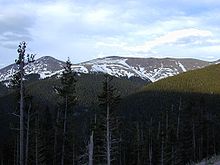
Back خط الشجر Arabic Meşə sərhədləri Azerbaijani Mediu lėnėjė BAT-SMG Límit arbori Catalan Hranice lesa Czech Trægrænse Danish Wald- und Baumgrenze German Arbarlimo Esperanto Límite del bosque Spanish Metsapiir Estonian


The tree line is the edge of a habitat at which trees are capable of growing and beyond which they are not. It is found at high elevations and high latitudes. Beyond the tree line, trees cannot tolerate the environmental conditions (usually low temperatures, extreme snowpack, or associated lack of available moisture).[1]: 51 The tree line is sometimes distinguished from a lower timberline, which is the line below which trees form a forest with a closed canopy.[2]: 151 [3]: 18
At the tree line, tree growth is often sparse, stunted, and deformed by wind and cold. This is sometimes known as krummholz (German for "crooked wood").[4]: 58
The tree line often appears well-defined, but it can be a more gradual transition. Trees grow shorter and often at lower densities as they approach the tree line, above which they are unable to grow at all.[4]: 55 Given a certain latitude, the tree line is approximately 300 to 1000 meters below the permanent snow line and roughly parallel to it.[5]
- ^ Elliott-Fisk, D.L. (2000). "The Taiga and Boreal Forest". In Barbour, M.G.; Billings, M.D. (eds.). North American Terrestrial Vegetation (2nd ed.). Cambridge University Press. ISBN 978-0-521-55986-7.
- ^ Jørgensen, S.E. (2009). Ecosystem Ecology. Academic Press. ISBN 978-0-444-53466-8.
- ^ Körner, C. (2012). Alpine Treelines: Functional Ecology of the Global High Elevation Tree Limits. Illustrated by S. Riedl. Springer. ISBN 978-3-0348-0396-0.
- ^ a b Zwinger, A.; Willard, B.E. (1996). Land Above the Trees: A Guide to American Alpine Tundra. Big Earth Publishing. ISBN 978-1-55566-171-7.
- ^ "Why treelines?".
© MMXXIII Rich X Search. We shall prevail. All rights reserved. Rich X Search